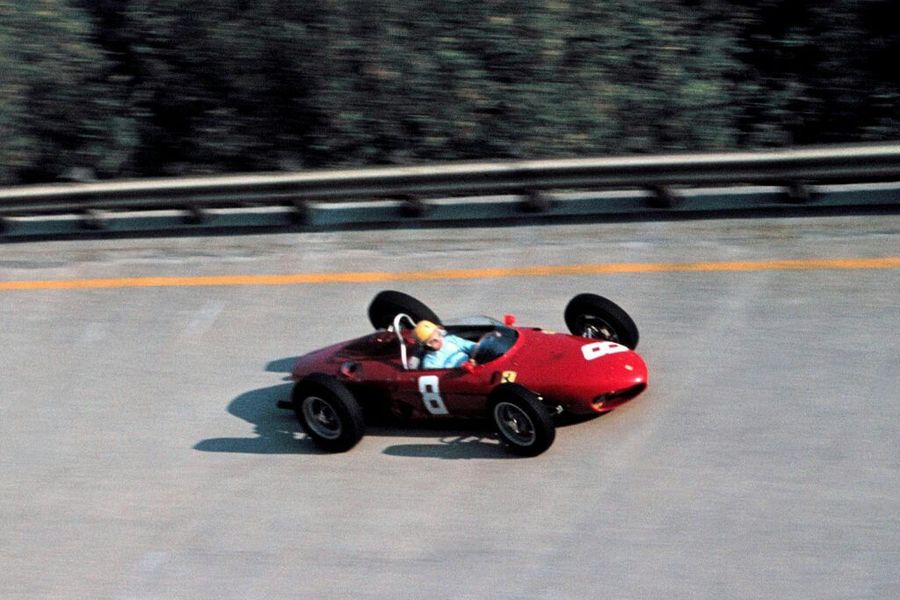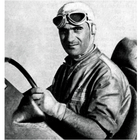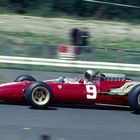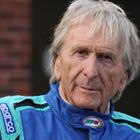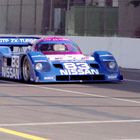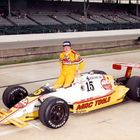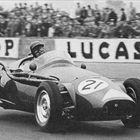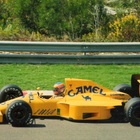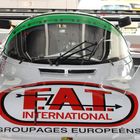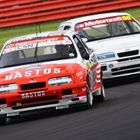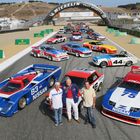On This Day: Ricardo Rodriguez Born, the Kid Who Could Have Been King
- 14 Feb 2020
- On This Day
 By Stephen Latham
By Stephen Latham
Ricardo Rodriguez de la Vega was born on Valentine’s Day, February 14th, in Mexico City in 1942, and would become known there as El Chamaco, ‘The Kid’. His father amassed considerable wealth from different business interests in the 1950s, at one time being head of the country's elite motorcycle police unit.
At the age of thirteen, his brother Pedro had become motorcycle champion for two consecutive seasons while Ricardo started out competing on bicycles. He went on to emulate Pedro’s achievements by becoming the national motorcycle champion, and winning several Mexican championships in different classes. He quit motorcycle racing in 1957 to concentrate on cars, when just 15 years old, and after a Fiat 500 Topolino, he moved on to an OSCA 1500 (taking third in the GP Avandaro) and then a Porsche 550 RS.
After a podium at Puebla (a tough mountain course) he entered a road race course but after the organisers combined the field he found himself racing his RS Porsche against Chevrolets, D Type Jaguars, Ferraris, many driven by experienced race drivers - and a 15 year old Ricardo won the race! He made his US debut at Riverside and stunned the locals by winning the under 1.5 litre class, with Carroll Shelby commenting "he's great, and cool as a cucumber at all times. He has that certain driving finesse which makes Fangio the champion that he is." Later in the year came the Nassau Trophy, where he took a class win in one race, competing in races there against the likes of Stirling Moss, Richie Ginther and John Fitch in big engined cars.
In the following year he continued to take wins with the Porsche, in Guadalajara, Aguascalientes and the GP Avandaro then late in the year at Nassau. In June that year he travelled to Le Mans with brother Pedro, planning to enter the race, but was refused entry because he was too young (just 16 years and four months). There was a victory early in 1959 at Leon, ahead of second placed Pedro and he was allowed to race at Sebring, with Frank Bott in an OSCA S950 after the FIA ruled age was not a factor if ability was proved. He took podiums with Porsches in the GP Avandaro and at Lago de Guadalupe plus a fifth at Riverside and by the end of the year was racing a Dino 196S and a Testa Rossa 250 to podium finishes at Nassau.
He was finally allowed to enter Le Mans in 1960 and made an impression when he and Andre Pillette finished second for Luigi Chinetti’s North American Racing Team, behind Paul Frere and Olivier Gendebien’s works Ferrari. At the age of 18 years and 133 days, he became the youngest driver at that time to finish on the podium. Earlier in the year he raced in Cuba and while there could be seen practising his Le Mans type starts, leaping over the door into his Porsche 1600 RSK. Proud of his country, Ricardo added his own adornment to the car by using electrical tape to write MEXICO in block letters on the faring behind his head restraint.
Following this he went on to partner Pedro in the Ferrari Dino at Sebring, the Targa Florio and Nurburgring before heading to Le Mans; they were seventh in Sicily but retired at Sebring and the Nurburgring. In December at Nassau he won the Governor’s Trophy in Luigi Chinetti’s Ferrari 250 plus he and Pedro co-drove it to second place in the Nassau Trophy (being Dan Gurney).
In January 1961 he won his first single-seater race, driving a Cooper Formula Junior at Mexico City, beating drivers including Hap Sharp, Jim Hall and brother Pedro. At the same event, he also won three races in different classes, using a Sunbeam Rapier, an Alfa TI and a Corvette. Following this, he appeared as lead actor in a motor racing movie, with the Cooper painted in Pepsi-Cola colours complete with bottle top logos.
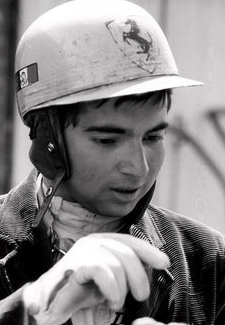 In the World Sportscar Championship he and Pedro finished third in the Sebring 12 Hours and second in the Nurburgring 1000 Kms. At Le Mans, they retired almost at the end of the race but had been involved in an epic four-way duel for the lead throughout the night. Before the year was out he and Pedro won the Paris 1000 Kms in a 250GT but Ricardo had already been invited to race for Ferrari in the Italian Grand Prix and sensationally qualified on the front row, just a tenth slower than World Championship leader Wolfgang Von Trips and ahead of the Ferraris of Phil Hill and Ritchie Ginther.
In the World Sportscar Championship he and Pedro finished third in the Sebring 12 Hours and second in the Nurburgring 1000 Kms. At Le Mans, they retired almost at the end of the race but had been involved in an epic four-way duel for the lead throughout the night. Before the year was out he and Pedro won the Paris 1000 Kms in a 250GT but Ricardo had already been invited to race for Ferrari in the Italian Grand Prix and sensationally qualified on the front row, just a tenth slower than World Championship leader Wolfgang Von Trips and ahead of the Ferraris of Phil Hill and Ritchie Ginther.
He ran well in the race, challenging Hill and Ginther for the lead until retiring due to a fuel pump failure though had become the youngest driver to debut in an F1 race. However, any performance or result was overshadowed by Wolfgang Von Trips’s accident in which he and fourteen spectators were killed. Jo Ramirez, who became a close friend of Ricardo, said “It was a tough start to Ricardo’s F1 career. He got on very well with von Trips, who was always kind to him, and gave him bits of advice-which surprised him, because senior drivers aren’t always like that! He was terribly upset when Wolfgang died.”
Despite his early retirement from the race, his performance encouraged Enzo Ferrari to sign him for a full season for the 1962 season. Continuing to race sports cars that year alongside his F1 racing, he was second in a Ferrari Dino with Phil Hill in the 3 Hours of Daytona plus raced a 250 TRI there with Pete Ryan. There were retirements at Sebring and the Nurburgring with Pedro but in May he won the Targa Florio alongside Gendebien and Willy Mairesse. The brothers failed to finish at Le Mans, though Ricardo had set the fastest lap and they led for several hours against the Ferrari of Phil Hill and Gendebien and then in the October they repeated their win at the 1000 Kms of Paris, at Montlhery. Sadly, this was their last race together as a few days later Ricardo would enter the Mexican F1 GP.
In 1962’s F1 campaign, he spun twice in the Netherlands and retired seven laps from the end but at Monaco the team decided to race Willy Mairesse in his place. In Belgium, after starting seventh he battled for third against team-mate Phil Hill, before finally finishing fourth and became the youngest driver to score points in Formul One (aged 20 years and 123 days-a record that remained unbroken for 38 years). There was a second place finish in a non-championship race at Pau, behind Maurice Trintignant though ahead of drivers including Lorenzo Bandini, Nino Vaccarella, Jo Siffert and Trevor Taylor.
Jo Ramirez was involved with Ferrari and travelled to all the races with Ricardo and his wife Sarita and the Pau race was on the same day that Stirling Moss had his Goodwood accident. Afterwards, he told how Ricardo was happy with his result but “distraught to hear about Stirling, whom he worshipped. It made him very sad-apart from anything else, he so much loved the idea of racing against him.” The team did not compete in France due to an industrial strike in Italy, which prevented the mechanics preparing the cars and they only entered a car for Phil Hill in the British GP.
He was sixth in Germany while at Monza, he started eleventh, four places ahead of Hill but retired due to engine failure on lap 64. Ferrari did not race at Watkins Glen or South Africa but when they elected not to contest the non-Championship Mexican GP, at the Magdalena circuit, he was determined to race in front of his countrymen. Ferrari felt it was an unnecessary risk and did not want him to compete but he did not want to let down the Mexican fans so agreed to race with Rob Walker’s Lotus 24.
Jo Ramirez took him to the airport in Milan for his trip to Mexico and told how he was so full of enthusiasm, “to race at his home track, in front of his own people…We were talking about the future, and he said how much he was looking forward to driving Rob’s car. Like everyone, he really liked Rob because he was such a gentleman.”
In a footnote about the Magdalena-Mixhuca circuit, the idea for it came from their father, Pedro Natalio Rodriguez, who was an advisor to then Mexican President Adolfo Lopez Mateos. In 1958, he suggested a track be built to allow the brothers and other Mexican drivers the chance to compete in front of an international audience. It opened in December 1959 and in its first ever event, the Mexico City 500, Ricardo finished third in an Alfa Romeo, behind Pedro Rodriguez and Moises Solana, in a Volvo and Alfa Romeo.
Desperately wanting to win the first Mexican F1 GP, he was the first driver out on track when it opened for non-official practice on the Thursday before the race. For most of the day he was fastest but after finishing for the day, John Surtees set the fastest time in a similar car so Ricardo decided to go back out again to get back the fastest lap. There were differing accounts but some witnesses said that they saw something break at the rear of the car, which then veered sharply to the left in the fearsome Peraltada corner and crashed heavily.
Ricardo had no chance and was thrown clear of the car, suffering fatal head and neck injuries. Mexico went into mourning as he was regarded as a national hero and the President attended his funeral. Shortly before his death he had been declared the country’s Athlete of the Year plus at one time had appeared on the front cover of Sport’s Illustrated, with the headline ‘Mexico’s Young Fireball’. Rob Walker told how he was the first driver to die in one of his cars and it was a traumatic time for him. He had substantial life insurance cover for his drivers but rather than give it to Ricardo’s father, gave it to Ricardo’s widow Sarita, due to the harsh treatment she received.
Jo Ramirez described him as “full of charm-one of those people who just gets on with everybody. He was always in a good humour, always laughing. OK, he’d get upset if he didn’t finish a race because his car broke, but later he’d be at the party. He absolutely lived life to the full…Ricardo was friends with all of them, not least Jim Clark, of whom he was very fond. He had good relationships with his team-mates, but he wasn’t frightened by them at all-he was quite sure he was quicker than they were.”
However, his bravery and seeming fearlessness worried many of his fellow drivers, with Graham Hill stating “I liked Ricardo a lot and thought he had tremendous talent-but I also thought, ‘If he lives, I’ll be surprised.”
Even Enzo Ferrari expressed concern for him, writing in his memoirs “I think if he learns to control his enthusiasm, to refine his style, he could have tremendous success. I said to him, ‘Ricardo, I’ll be frank with you. You’ll only be the great racer you want to be if you learn control. If not, I’m not sure how much longer your talent for improvisation will save you’. Ricardo flashed that smile of a kid who has grown up too fast, and said yes, he had got the message. But I was worried. I knew he was being eaten alive by blind ambition, that he was dangerously eager. And I also knew his family was kindling his ambition, rather than trying to cool it-in fact, I wrote to his father about it. He’s a wild guy who races with a frightening lack of restraint and an excess of physical energy without compare.
“I think that if this youngster learns to contain his impetuosity and refines his driving style, he can be very successful…I understood that his desire to win devoured him. It was a noble ambition but it laid dangerously in wait for him. And I knew that, in his family he would not find water to put out his fire, but petrol. I had to read in the papers that, because of excess speed, in an attempt to beat a record taken from him moments earlier by another competitor, during practice for the Mexican Grand Prix, he went off the road in a Lotus. This time, fate was not kind to him. He was twenty and was such a good kid, always cheerful, with that innocent face of a naughty child.”
After Ricardo’s death, Pedro announced his retirement though some months later changed his mind and went back to racing. Following the crash, Pedro wore Ricardo’s favourite ring, “In order to feel always his presence…As long as I wear that ring, I will never suffer anything.” Sadly, he lost his life in a crash at the Norisring in 1971 but a few days before he had lost the ring in an airport washroom. He had taken it off to wash his hands, but when he came back to find it had gone.
The circuit in Mexico City would later be renamed the Autodromo Hermanos Rodríguez to honour Ricardo and Pedro. In 2012, Jo Ramirez attended a simple ceremony in memory of him; “We all congregated at Peraltada, the corner where he lost his life, and at eight minutes past five - exactly the time of the accident - we had a minute’s silence, and then we walked the last 200 metres, to complete symbolically his final lap. Even now, fifty years on, it still seems so sad. Ricardo didn’t even live to see his 21st birthday, but he did more in his life than people three or four times his age. Those of us who knew him, who were close to him, believed he would be one of the greatest-he was so gifted-but we all wondered if he would live long enough…”
He stated: ”I may be biased, but I think Ricardo would have become another Prost or Senna. He was very, very special. To get a guy who comes to F1 and makes the sort of impression he did at Monza in '61 that only happens maybe once every 10 years."
Popular Articles
-
 December Podcast: Book Month as the Team Suggest some Stocking Fillers from Santa6 Dec 2025 / Podcast
December Podcast: Book Month as the Team Suggest some Stocking Fillers from Santa6 Dec 2025 / Podcast -
 November Podcast: Jim Clark, the Man, the Museum and the Greatest Season in Motorsport11 Nov 2025 / Podcast
November Podcast: Jim Clark, the Man, the Museum and the Greatest Season in Motorsport11 Nov 2025 / Podcast -
 October 2025: Romain Dumas - Le Mans Winner and Historic Ace!3 Oct 2025 / Podcast
October 2025: Romain Dumas - Le Mans Winner and Historic Ace!3 Oct 2025 / Podcast -
 September 2025: Nigel Mansell Talks Formula One, Indycar and More!10 Sep 2025 / Podcast
September 2025: Nigel Mansell Talks Formula One, Indycar and More!10 Sep 2025 / Podcast


